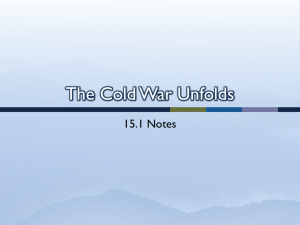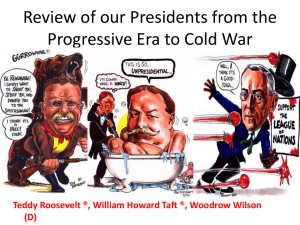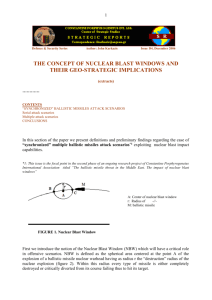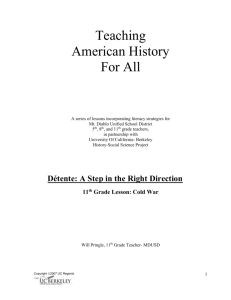The Evolution of Deterrence
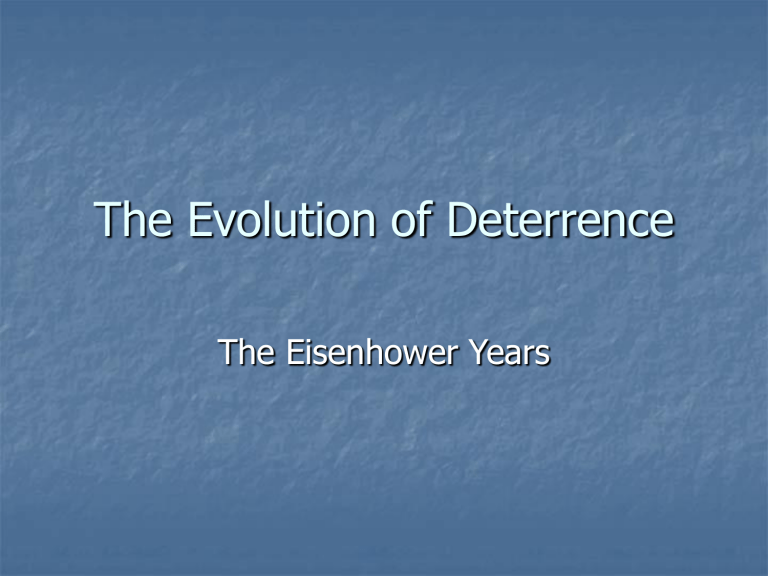
The Evolution of Deterrence
The Eisenhower Years
Eisenhower elected in 1952
Concerned about the large increases in defense spending in the last years of the Truman administration.
But also worried about
Communist expansionism.
The “New Look”
Limit defense spending.
To contain Communism:
Rely upon U.S. nuclear arsenal.
For proxy wars involving allies, assist with air and sea forces.
Expressed in NSC-162/2 (October 1953)
Secretary of State:
John Foster Dulles
In January 1954, gives a speech stating administration’s decision:
“to depend primarily upon a great capacity to retaliate, instantly, by means and at places of our choosing.”
Sparks creation of the term
“Massive Retaliation.”
Means of “retaliation”
Initially, Strategic Air Command
B-52 Stratofortress enters service, 1955
The Missile Age
Sputnik launched
October 4, 1957
U.S. military branches had already been pursuing strategic missile programs.
U.S. Strategic Missile Programs
Atlas (ICBM, USAF)
Titan (ICBM, USAF)
Thor (IRBM, USAF)
Snark (cruise missile,
USAF)
Jupiter (IRBM, Army)
Polaris (IRBM/FBM,
USN)
Nuclear submarines
First: U.S.S. Nautilus (1955)
First ballistic missile submarine: U.S.S. George
Washington (1960)
Criticisms of the New Look and
Nuclear Deterrence
For a crisis elsewhere in the world, how credible was an American threat of heavy retaliation when the U.S.S.R. had the capacity to inflict massive damage on the
U.S. itself?
What if the Soviet Union launched a preemptive strike at the U.S. strategic nuclear arsenal?
Problems assessing Soviet capabilities
By mid-1950’s Soviet internal security blocks sources of human intelligence.
Other attempts to obtain intelligence:
National Security Agency (NSA) formed in
1952 to listen to radio traffic.
CIA – wiretapping phones
Radar stations established around periphery of U.S.S.R.
U-2 overflights
Lack of knowledge enhances fear of U.S. vulnerability
“bomber gap” debate: 1954-56
Sputnik launch, 1957
“missile gap” issue at end of Eisenhower administration
Civilians shape deterrence policy
Gaither Committee (report: November 1957)
RAND Corporation
Prominent theorists:
Bernard Brodie
Herman Kahn
William Kaufman
Henry Kissinger
Thomas Schelling
Albert Wohlstetter
The Problem of Pre-emption
If a pre-emptive strike could destroy a nation’s nuclear arsenal, that arsenal may not deter war, but could actually encourage an attack.
Could create an unstable political environment where a crisis could encourage such a strike.
Nuclear Deterrence:
A short lexicon
First strike (one that attempts destroy enemy’s weapons)
Second strike (one that can survive a first strike and retaliate)
Counterforce (strike on military targets)
Countervalue (strike on civilian targets)
Other aspects of Eisenhower administration security policy
Alliances
Arms talks
Economic and military aid, and covert actions, to defeat communist insurgencies.
NATO & the Federal Republic of
Germany (West Germany)
First formed in 1949.
“Fully sovereign” in 1955.
Acquired full control over its domestic and foreign policy.
Formed the Bundeswehr, would grow to 12 divisions (500,00 men) and become integrated into NATO.
Would only arm with nuclear weapons if order to by NATO.
NATO & Nuclear Weapons
1954: Adopts “New Look” approach of relying more on nuclear arms in place of larger conventional forces.
Initial assumption that tactical nuclear devices could be used to defend against a
Soviet invasion.
Thousands of such weapons deployed to
Europe in 1950’s
Nukes & European expectations
U.S. emphasis on nuclear arsenal to deter war with U.S.S.R. made nuclear weapons a symbol of American commitment to defend Europe.
Implications?
Asia
U.S. signs bilateral pacts with South Korea
(1953) and Taiwan (1955).
Gets Japan to maintain a minimal defense force – but it won’t accept nuclear arms.
Southeast Asia Treaty Organization (SEATO) formed, 1954:
Initial members: U.S., U.K., France, Philippines,
New Zealand, Australia, Pakistan, Thailand.
Laos, Cambodia, and South Vietnam added shortly thereafter.
The problems with allies
Small-scale conflict between Nationalist and Communist
Chinese, 1953-54 and
1958.
Ongoing border incidents along
Korean DMZ.
Indochina
French suffer large defeat at Dien Bien
Phu, 1954.
U.S. gets France to negotiate with
Viet Minh
Vietnam divided at
17 th parallel
The Middle East
The Baghdad Pact, 1955
U.S. pressures U.K., Iran , Iraq, Pakistan &
Turkey to form alliance.
Effort to deter Soviet pressure in the oil-rich region, which was unstable given the waning of British influence.
Later, U.S. joins alliance; becomes known as the Central Treaty Organization (CENTO) in
1959.
More problems with allies
The Suez Crisis (1956-57)
President Gamal Abdel Nasser orders nationalization of Suez Canal.
Israel, Great Britain & France invade, occupy
Canal Zone and Sinai.
U.S. pressures and occupying countries to withdraw.
The Eisenhower Doctrine, 1957
President pledges U.S. assistance to any
Middle Eastern country threatened by aggression from any state “controlled by international communism.”
Does not prevent continuing problems in region, 1957-58:
Iraq: coup deposed monarchy, new regime leaves Pact.
Jordan: monarchy threatened
Lebanon: sank into civil war.
Latin America
Cuba: Batista regime collapses in 1959,
Fidel Castro comes to power.
Communist movements active in
Columbia and
Venezuela.
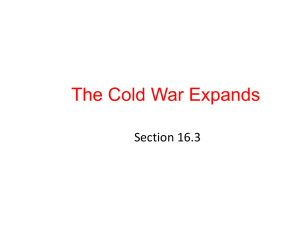

![The Politics of Protest [week 3]](http://s2.studylib.net/store/data/005229111_1-9491ac8e8d24cc184a2c9020ba192c97-300x300.png)





